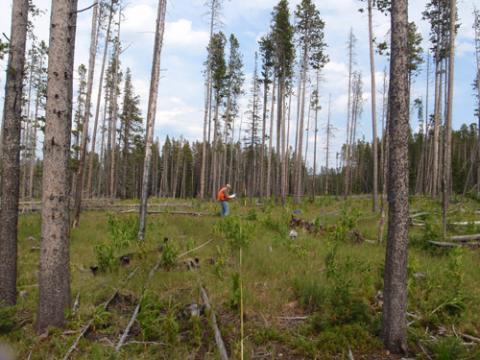Using Silvicultural Treatments and Prescribed Burning to Restore Multi-aged Lodgepole Pine Forests
Lodgepole pine is one of the most widely distributed conifers in North America. The adaptations of lodgepole pine to severe, stand-replacement fire–in particular its serotinous cones–have long been acknowledged. Less well-known is that lodgepole pine forests also burn in low- to mixed-severity fire, resulting in patchy and variable patterns across the landscape. Recognition of the extent of the mixed-severity fire regime in lodgepole pine has led to increased efforts toward more ecologically based management of lodgepole pine. This was the basis for a project to design silvicultural and prescribed fire treatments lodgepole pine forests in the Northern Rocky Mountains.
The Tenderfoot Creek Research Project was designed to evaluate and quantify the ecological and biological effects of restoration treatments in an attempt to both manage fuelbed profiles and create two-aged stand structures in lodgepole pine. A suite of five fire and silvicultural treatments was implemented between 1999 and 2003 on the Tenderfoot Creek Experimental Forest (TCEF) in central Montana to test how to best maintain a lodgepole pine overstory while also establishing a new cohort of lodgepole pine regeneration.
Our results indicate that even-distribution thinning alone or combined with prescribed fire results in extremely low overstory density. Homogenous prescribed burning of any intensity in lodgepole pine, especially stands with activity fuels present, will almost always result in high mortality and is not recommended if retention of overstory trees is desired. For areas where windthrow is a concern, we recommend variable retention harvests similar to the group shelterwood described in this guide. The group shelterwood fostered lodgepole pine regeneration in the cut corridors while maintaining lodgepole pine in the overstory in the leave patches. This treatment demonstrated that fire does not spread well in lodgepole under typical prescribed fire burning conditions without some type of prior mechanical treatment. With careful marking, it is possible to create a heterogeneous, two-aged lodgepole pine stand using the group shelterwood treatment both alone and in conjunction with prescribed burning.
For a more indepth overview, see our TCEF Story Map
